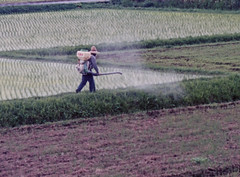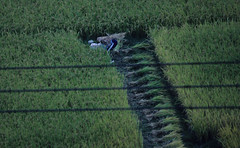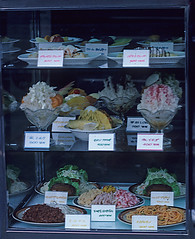What’s Japanese for “Locavore?” Oh, Never Mind.
 That Japanese agriculture is a political issue is no surprise. As in the United States, agriculture is the recipient of political and economic support, is seen as both an economic engine and a strategic resource, and despite decades of technological and social change, is still viewed as a repository of historical and traditional values.
That Japanese agriculture is a political issue is no surprise. As in the United States, agriculture is the recipient of political and economic support, is seen as both an economic engine and a strategic resource, and despite decades of technological and social change, is still viewed as a repository of historical and traditional values.
A bit over two years ago, the Japanese Ministry of Agriculture put out a video (below the fold) decrying the high levels of food imports, rising obesity and food waste which had come along with the shift to a more prosperous, diverse and Western-style diet. It’s not entirely clear, given the production capacity limitations of Japanese agriculture which the video also details, that the Ministry really thinks it can decrease imports, but perhaps a little less waste and smaller waists would be a good thing? Clearly food security is a concern: the small number of countries from which Japan imports most of its food is cited as a problem, though again there’s no suggestion here that Japan might relax its import controls, etc., to facilitate a broader market.
 The political aspect of the problem has been heightened by the recent political shifts in Japan, which included some discussion of significant changes in agricultural price supports as a way to streamline the government, move agriculture forward and perhaps even fulfill some of Japan’s obligations towards more open trade in foodstuffs. Agricultural policy has rarely shifted much in post-WWII Japan, with rural and agricultural interests strongly tied to the long-dominant LDP, though there have been discussion of problems in land use policy, economics, diplomatic relations, the rapid aging of rural populations even more rapid than the general population and exodus of Japanese women. Because of the political linkages, and the tendency of modern Japanese nationalism to revolve around rice agriculture, very little has been done: Japan’s agriculture remains expensive, inefficient, and politically powerful.
The political aspect of the problem has been heightened by the recent political shifts in Japan, which included some discussion of significant changes in agricultural price supports as a way to streamline the government, move agriculture forward and perhaps even fulfill some of Japan’s obligations towards more open trade in foodstuffs. Agricultural policy has rarely shifted much in post-WWII Japan, with rural and agricultural interests strongly tied to the long-dominant LDP, though there have been discussion of problems in land use policy, economics, diplomatic relations, the rapid aging of rural populations even more rapid than the general population and exodus of Japanese women. Because of the political linkages, and the tendency of modern Japanese nationalism to revolve around rice agriculture, very little has been done: Japan’s agriculture remains expensive, inefficient, and politically powerful.
But it was also popular: while half of Japan’s food may have been imported, Japanese were loath to admit it or discuss it, and when asked would invariably cite Japan-produced food as healthier (ignoring the dioxin-laden chemical load) and better suited to Japanese tastes (despite decades of blind-test results). While Japanese agriculture may have had problems, it also had an immensely strong hold on Japanese consumers. But no more.
The food crisis in Japan has shifted. As I said in the aftermath of the 3/11 disaster,
The rural areas of the Tohoku coast may never recover, and if it does, it will be a different place. Fukushima is a center of food production, especially vegetables for Tokyo’s consumption, and aside from the short-term disruption in supplies, there are going to be long-term issues with radiation exposure even if the Fukushima Daiichi plant problems are completely solved today: combining food safety issues, which make everyone panic, with radiation is a recipe for long-term avoidance.
 While my track record as a pundit is as mixed as anyone's, this NYT report by Martin Fackler suggests that I called this one. The Japanese government, overwhelmed with conflicting demands and extremely limited political will, not to mention a bureaucratic/corporate culture that shifted from hyper-responsibility to finely tuned disavowal at some point in the last few decades, (the lawyerly responses from Tohoku Electric are worthy of some of America’s most weasely corporate flacks) has been doing a very spotty job monitoring radiation contamination in food, and an even worse job responding to it. Farmers have begun testing their own crops, but in the absence of a clear policy, to do the responsible thing may well mean massive financial losses: neither TEPCO nor the government have begun to grapple with the true scale of either the cleanup or the compensation necessary to move on.
While my track record as a pundit is as mixed as anyone's, this NYT report by Martin Fackler suggests that I called this one. The Japanese government, overwhelmed with conflicting demands and extremely limited political will, not to mention a bureaucratic/corporate culture that shifted from hyper-responsibility to finely tuned disavowal at some point in the last few decades, (the lawyerly responses from Tohoku Electric are worthy of some of America’s most weasely corporate flacks) has been doing a very spotty job monitoring radiation contamination in food, and an even worse job responding to it. Farmers have begun testing their own crops, but in the absence of a clear policy, to do the responsible thing may well mean massive financial losses: neither TEPCO nor the government have begun to grapple with the true scale of either the cleanup or the compensation necessary to move on.
The video, while the dancing chickens and bopping cows may remain entertaining, is now an historical relic. The encouragement of domestic consumption as an economic and healthy alternative is going to fall on increasingly deaf ears until there are solutions and those solutions have been shown to be effective. Perhaps the most significant change to come from this massively traumatic series of events is going to be a new level of suspicion and self-reliance among Japanese citizens. The idea of corporations as responsible community members may have been destroyed in one fell swoop; the idea of government as competent, prepared, and responsive has been dying for years, at least since the HIV-tainted blood product scandals of the '80s, but the goodwill built up by the seismic retrofitting and disaster prep after the ’95 Hanshin quake was squandered in a matter of days. The farmers checking their own crops, the citizens monitoring foodstuffs in stores and setting up radiation stations: this may be the beginning of new kind of citizen engagement, the spirit of independence and voluntarism that many decried as lacking sixteen years ago.
